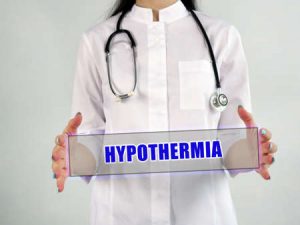Table of Contents
What is hypothermia?

Hypothermia is a medical condition that happens when the body is exposed to cold for a long time. The normal body temperature is 98.6°F or 37°C. You have hypothermia if your body temperature drops below 95°F or 35°C.
Hypothermia is dangerous and can be life-threatening. If left untreated, hypothermia can cause a heart attack, liver damage, kidney failure, or death.
How bad is my hypothermia?
Mild: The body temperature ranges between 35 – 32°C (95 – 89.6°F ). The symptoms are cool, pale skin, numbness, drowsiness and shivering. medical treatment is not indicated. Most of the time, mild symptoms can be safely managed at home by following the tips given in the section below.
Moderate: The body temperature remains between 32 – 28°C (89.6 – 82.4°F ). The symptoms are loss of consciousness, unsteady walk, slow breathing rate and low blood pressure.
Severe: The body temperature remains less than or equal to 28°C (82.4°F ). You may have slow heart rate, dilated pupils, rigid muscles and shortness of breath (dyspnea). Severe hypothermia may cause life-threatening consequences (e.g., coma, hypotension, pulmonary edema, ventricular fibrillation). It requires immediate treatment under your doctor’s supervision.
How to manage mild hypothermia?
Keep track of your body temperature using Ankr (myAnkr web portal or the Ankr app). It will help you describe the problem to your doctor or nurse.
- Prepare for cold weather. Warm clothing and hats retain heat. Wear layers to prepare for changing conditions.
- Proper winter clothing includes:
- Mittens (not gloves)
- Raincoat and windbreaker
- Two pairs of socks (not cotton)
- Scarf and hat (that covers the ear)
- If you get wet, change your clothes immediately. Look for a warm, indoor place.
- Keep extra items in your car when traveling (clothes, food, water, and blankets).
- Do not eat snow or drink alcohol. This lowers your body temperatures.
- In cold temperatures, stay active to produce body heat and store energy.
- Keep your heat at home above 68°F. Close the vents and doors in rooms you don’t use. This retains heat and saves money.
- Care for babies. Check in on elderly people. Make sure they are warm, dry, clothed, and fed.
How to manage moderate and severe hypothermia?
For cases where there is moderate to severe hypothermia (where the core temp can get down as low as 85º F), seek medical attention quickly. When the core of the body is cold to the touch, the pulse has slowed severely, weak breathing or a loss of consciousness has occurred, visit a doctor immediately.
What causes hypothermia?
A drop in your body temperature and lack of stored energy causes hypothermia. When body temperature drops, it uses stored energy to stay warm. Your body can no longer produce heat. There are a few types of this condition with varying causes.
Acute
This occurs when your body temperature drops suddenly. This can happen if you fall into cold water. Hikers, hunters, and people who are without housing are at risk. People stranded outside in the cold for too long are at risk.
Chronic
This occurs when your body temperature drops over a period of time. Elderly people and babies have a harder time controlling their body temperature. They are at risk of getting hypothermia over time. People of low incomes who don’t have access to heat or proper clothing are at risk.
Exhaustion hypothermia
When your body temperature drops due to the inability to produce heat, it causes exhaustion hypothermia. People who are sick, have certain health conditions, or have substance use disorders are at risk.
Perioperative hypothermia
This occurs when your body temperature drops after surgery in a hospital. It can be hard to maintain heat after receiving anesthesia.
Other causes
Certain medical conditions such as diabetes and thyroid conditions, some medications, severe trauma, inability to produce adequate body heat, using drugs or alcohol all increase the risk of hypothermia.
